 By Rodney Dickens, MD of Strategic Risk Analysis Having worked for international investment banks for 12 of my 28 year career to date it is almost unfathomable that a premium investment bank like Lehman Brothers could go bankrupt or that Merrill Lynch could end up in such bad shape that it had to be taken over by Bank of America. It is equally surreal that the US government had to step in and rescue Fannie Mae and Freddie Mac (although with names like these what more can one expect?), or that the Federal Reserve would have to bail out the largest insurance company around (AIG). However, students of the history of banking will see the recent events as just a larger than normal example of the sort of madness the banking sector seems to thrive on. We only have to look back to the events that unfolded after the 1987 equity market collapse and commercial property market tumble in NZ to be reminded that major banks are not exempt from making such silly decisions and going down the gurgler.
By Rodney Dickens, MD of Strategic Risk Analysis Having worked for international investment banks for 12 of my 28 year career to date it is almost unfathomable that a premium investment bank like Lehman Brothers could go bankrupt or that Merrill Lynch could end up in such bad shape that it had to be taken over by Bank of America. It is equally surreal that the US government had to step in and rescue Fannie Mae and Freddie Mac (although with names like these what more can one expect?), or that the Federal Reserve would have to bail out the largest insurance company around (AIG). However, students of the history of banking will see the recent events as just a larger than normal example of the sort of madness the banking sector seems to thrive on. We only have to look back to the events that unfolded after the 1987 equity market collapse and commercial property market tumble in NZ to be reminded that major banks are not exempt from making such silly decisions and going down the gurgler.
If it wasn't for a Government rescue, the BNZ may well have disappeared after the 1987 crash, while the rising star NZI Bank, a subsidiary of the blue-chip NZI Corporation that also owned NZI Insurance, lost around $1 billion and went belly up. I was chief economist at NZI Bank at the time of the 1987 crash so have some first hand insight into banking sector madness although I can't claim any credit for the astonishing disappearance of NZI Bank. On the global stage there was the savings and loan crisis in the US in the 1980s and 1990s when 747 savings and loan associations failed (see here), there was the prolonged Japanese banking crisis in the 1990s (see here), while Latin America was at it in the 1980s (see here). In 1991 I co-authored a booklet for the NZ Bankers' Association titled 'Banking in New Zealand' (it is now in its fourth edition, see here) and one of the sections I wrote in the booklet was on the history of banking. One of things the research I did for this section of the booklet taught me was the moral hazard in the banking sector. The explicit or implicit guarantees the government gives to prop up the banking sector in times of trouble, as is happening now in the US and happened in Japan, increases the odds that banks will fail. The result of Government direct and indirect involvement in the banking sector, including implicit or unspoken guarantees, is that banks these days operate with much lower equities levels than did the early banks, which makes them vulnerable to negative shocks. While it is likely that the Government guarantees, even when they are only unspoken, mean that banks take more risks than is sensible at certain times (see the next paragraph). The unfolding events in the US make a mockery of prudential management of the banking sector by central banks. The other lesson from my research was that pretty much every time a part of the world booms (be it East Asia, the East Indies, South America, Japan or the USA), or a particularly industry or market booms, the banks will fuel the flames and a banking crisis of some proportion will follow. The recent boom in bank lending to NZ dairy farmers might prove to be a minor case in point. My conclusion was that to avoid fueling the flames of an unsustainable boom or speculative bubble a banker had to be either 300 years old (i.e. have learnt the lessons of the many past banking mistakes) or have sound judgment (i.e. be willing to miss out on some balance sheet growth during the boom phase so as to avoid experiencing an imploding balance sheet when the music stops). But I have not yet met a 300 year old banker, while history suggests that sound judgment can be a scarce commodity in the banking industry. NZ banks appear to have largely learnt from the painful lessons taught by the 1987 crash and do not appear to have got themselves massively exposed to the parts of the NZ property market that are currently imploding. The most worrying speculative bubbles this time around are not the commercial property market or the housing market, but the apartment market and particularly various bits of the land market (e.g. the coastal and resort subdivision booms, residential subdivision booms in many parts of the country, land banking for future residential subdivisions, and parts of the industrial-commercial land/development market). These are the areas that have been inflicting the most pain on the financial system this time around. Clearly a significant number of finance companies either didn't learn the lessons dished out after 1987 or thought the subdivision and land banking booms could continue to defy gravity (i.e. they came up seriously short on the sound judgment front).  The banks will no doubt have their fingers in the segments of the property market that are currently imploding, and there will be problem loans, while mortgagee sales of houses and sections are on the rise, and banks will have to increase provisions for bad debts on this core part of their businesses (i.e. home lending). And once we have seen house prices fall another several percent over the next few months there will be a significant number of home borrowers with negative equity. But when compared to the madness of US home lending over the last few years, what has happened in NZ is pretty mild (i.e. micro madness of a somewhat painful but not overly concerning magnitude, not mega madness). Is the US madness reason for the RBNZ to repeat the mistakes it made in 2001 and 2003? Everything I read on the topic says the NZ-Australian banking systems are pretty sound. The unfolding tumble in the NZ property market will result in elevated problem loans for the banks but nothing close to life threatening levels, while we could be much of the way through the problems in the finance company sector. There will be write-offs associated with especially the larger Australian banks having exposure to the likes of Lehman Brothers, but the exposures and potential write-offs do not appear to be overly worrying when considered in terms of the size of the balance sheets of the banks. The main problem expected to flow from the latest round of carnage in the US banking sector is increased overseas funding costs for local banks. Local banks are reported to get 20-25% of their total funding from overseas wholesale markets (see source here). In response to the expected increase in overseas funding costs for the local banks the ANZ-National chief economist has been reported as calling for the RBNZ to cut the OCR a by 0.5% on both 23 October and 4 December (see source here). We can't monitor what is happening with overseas funding costs for local banks so we can't say how large this problem is, or will become, but we have reason to believe the ANZ-National chief economist may be making a meal of it. Not long ago it was argued in a BNZ report that rising international funding costs would limit downside for retail interest rates even if the RBNZ delivered many OCR cuts: "we note that even a stream of rate [OCR] cuts could well be just "whistling in the wind" in relation to having any material effect on retail interest rates" (see source here).
The banks will no doubt have their fingers in the segments of the property market that are currently imploding, and there will be problem loans, while mortgagee sales of houses and sections are on the rise, and banks will have to increase provisions for bad debts on this core part of their businesses (i.e. home lending). And once we have seen house prices fall another several percent over the next few months there will be a significant number of home borrowers with negative equity. But when compared to the madness of US home lending over the last few years, what has happened in NZ is pretty mild (i.e. micro madness of a somewhat painful but not overly concerning magnitude, not mega madness). Is the US madness reason for the RBNZ to repeat the mistakes it made in 2001 and 2003? Everything I read on the topic says the NZ-Australian banking systems are pretty sound. The unfolding tumble in the NZ property market will result in elevated problem loans for the banks but nothing close to life threatening levels, while we could be much of the way through the problems in the finance company sector. There will be write-offs associated with especially the larger Australian banks having exposure to the likes of Lehman Brothers, but the exposures and potential write-offs do not appear to be overly worrying when considered in terms of the size of the balance sheets of the banks. The main problem expected to flow from the latest round of carnage in the US banking sector is increased overseas funding costs for local banks. Local banks are reported to get 20-25% of their total funding from overseas wholesale markets (see source here). In response to the expected increase in overseas funding costs for the local banks the ANZ-National chief economist has been reported as calling for the RBNZ to cut the OCR a by 0.5% on both 23 October and 4 December (see source here). We can't monitor what is happening with overseas funding costs for local banks so we can't say how large this problem is, or will become, but we have reason to believe the ANZ-National chief economist may be making a meal of it. Not long ago it was argued in a BNZ report that rising international funding costs would limit downside for retail interest rates even if the RBNZ delivered many OCR cuts: "we note that even a stream of rate [OCR] cuts could well be just "whistling in the wind" in relation to having any material effect on retail interest rates" (see source here). 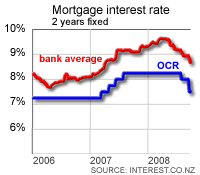 Since the BNZ report was written on 17 July, the OCR has been cut a total of 0.75%, from 8.25% to 7.5%, while the average fixed mortgage rate charged by the major banks has fallen 0.55%, from 9.5% to 8.95%. From the peak of 9.7% in April the average fixed mortgage interest rate has fallen 0.75%, exactly the same as the fall in the OCR, while some of the smaller banks like Kiwibank and TSB are doing a great job of keeping the larger banks honest by offering 2-year fixed rates just below 8.5% and in the case of Kiwibank, 8.29% for people with 20% or more equity in their home. So the suggestion in the BNZ report that a lower OCR might not result in lower retail interest rates has not proved correct, which places some doubt on the call for aggressive OCR cuts by the ANZ-National chief economist on the grounds that cuts are needed to offset the impact of rising international funding costs. There has to be some suspicion that the ANZ-National chief economist is crying wolf, although it could be a few weeks or months before this is proved to be the case (or not).
Since the BNZ report was written on 17 July, the OCR has been cut a total of 0.75%, from 8.25% to 7.5%, while the average fixed mortgage rate charged by the major banks has fallen 0.55%, from 9.5% to 8.95%. From the peak of 9.7% in April the average fixed mortgage interest rate has fallen 0.75%, exactly the same as the fall in the OCR, while some of the smaller banks like Kiwibank and TSB are doing a great job of keeping the larger banks honest by offering 2-year fixed rates just below 8.5% and in the case of Kiwibank, 8.29% for people with 20% or more equity in their home. So the suggestion in the BNZ report that a lower OCR might not result in lower retail interest rates has not proved correct, which places some doubt on the call for aggressive OCR cuts by the ANZ-National chief economist on the grounds that cuts are needed to offset the impact of rising international funding costs. There has to be some suspicion that the ANZ-National chief economist is crying wolf, although it could be a few weeks or months before this is proved to be the case (or not). 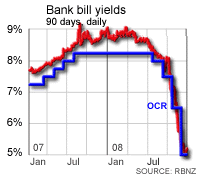 A clear sign of problems when the US banking crisis impacted on NZ in the second half of last year was that the 90-day bank bill yield, the key short-term wholesale interest rate that gives an indication of banks' funding costs on the local wholesale market, climbed materially relative to the OCR. Since the birth the OCR in March 1999, the 90-day bank bill yield has averaged 0.29% (or 29 basis points) above the OCR, but in August 2007 the margin almost reached 1%. Today the margin is at 0.33%, which is only a touch over average, so this measure of stress in the local banking system is not ringing warning bells like it was doing between August 2007 and March 2008. When we look at the gap between the average 6-month fixed mortgage interest rate and the 90-day bank bill yield we can see that the squeeze on margins associated with higher local wholesale funding costs evident late last year and earlier this year has ended. Similarly the squeeze in margins between the average five-year fixed rate and the 5-year swap rate (the relevant local wholesale interest rate) has also rebounded materially. With the margins between mortgage rates and local wholesale interest rates now more than fully restored, it seems that banks should be in a better position to withstand increased overseas funding costs now than they were late last year or even a couple of months ago. So hopefully you appreciated my skepticism in the need for the RBNZ to become super aggressive in cutting the OCR to ensure that the economy gets a dose of lower borrowing costs. There is more than a little irony in the prospect that the latest turmoil in the US banking sector could see margins of NZ banks - that have been much more prudent - squeezed. Possibly I am totally under-estimating the likely increase in overseas funding costs, but with one bank having already cried wolf you will most likely appreciate why I am at least a little skeptical about the last cry from the ANZ-National chief economist. And I'm sure most people other than maybe my ex-colleagues in the banking sector will question the desirability of operating monetary policy on the basis of pressure on bank margins. Doesn't everyone love a roller coaster ride?! If the bank economists ran monetary policy we would have experienced a more severe roller coast ride in the economy and especially in the housing market than we have been subjected to under Governor Bollard's misguided "go for growth" experiment since 2002 (see the recent Raving in which I renewed my call for more stable interest rates - here - or the earlier Raving about the costs of Bollard's experiment - here). During the extended period of experimentation with below average or sustainable interest rates between 2001 and 2006, the bank economists regularly called for even lower interest rates, while after the peak in the OCR was reached in July 2007 some of the same bank economists had changed spots and were predicting that the OCR would or should go even higher. If we have learnt anything from the operation of monetary policy this decade, it should be that cutting the OCR aggressively in response to an international shock, as occurred in 2001 and 2003 and is unfolding again, is the special sort of madness only central banks and bank economists seem to think is good for New Zealand's long-term growth prospects. When faced with an international crisis that will have a material impact on the NZ economy the exchange rate is the perfect buffer.
A clear sign of problems when the US banking crisis impacted on NZ in the second half of last year was that the 90-day bank bill yield, the key short-term wholesale interest rate that gives an indication of banks' funding costs on the local wholesale market, climbed materially relative to the OCR. Since the birth the OCR in March 1999, the 90-day bank bill yield has averaged 0.29% (or 29 basis points) above the OCR, but in August 2007 the margin almost reached 1%. Today the margin is at 0.33%, which is only a touch over average, so this measure of stress in the local banking system is not ringing warning bells like it was doing between August 2007 and March 2008. When we look at the gap between the average 6-month fixed mortgage interest rate and the 90-day bank bill yield we can see that the squeeze on margins associated with higher local wholesale funding costs evident late last year and earlier this year has ended. Similarly the squeeze in margins between the average five-year fixed rate and the 5-year swap rate (the relevant local wholesale interest rate) has also rebounded materially. With the margins between mortgage rates and local wholesale interest rates now more than fully restored, it seems that banks should be in a better position to withstand increased overseas funding costs now than they were late last year or even a couple of months ago. So hopefully you appreciated my skepticism in the need for the RBNZ to become super aggressive in cutting the OCR to ensure that the economy gets a dose of lower borrowing costs. There is more than a little irony in the prospect that the latest turmoil in the US banking sector could see margins of NZ banks - that have been much more prudent - squeezed. Possibly I am totally under-estimating the likely increase in overseas funding costs, but with one bank having already cried wolf you will most likely appreciate why I am at least a little skeptical about the last cry from the ANZ-National chief economist. And I'm sure most people other than maybe my ex-colleagues in the banking sector will question the desirability of operating monetary policy on the basis of pressure on bank margins. Doesn't everyone love a roller coaster ride?! If the bank economists ran monetary policy we would have experienced a more severe roller coast ride in the economy and especially in the housing market than we have been subjected to under Governor Bollard's misguided "go for growth" experiment since 2002 (see the recent Raving in which I renewed my call for more stable interest rates - here - or the earlier Raving about the costs of Bollard's experiment - here). During the extended period of experimentation with below average or sustainable interest rates between 2001 and 2006, the bank economists regularly called for even lower interest rates, while after the peak in the OCR was reached in July 2007 some of the same bank economists had changed spots and were predicting that the OCR would or should go even higher. If we have learnt anything from the operation of monetary policy this decade, it should be that cutting the OCR aggressively in response to an international shock, as occurred in 2001 and 2003 and is unfolding again, is the special sort of madness only central banks and bank economists seem to think is good for New Zealand's long-term growth prospects. When faced with an international crisis that will have a material impact on the NZ economy the exchange rate is the perfect buffer. 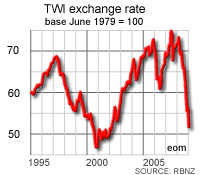 As the chart shows, when the East Asian crisis hit in 1987/88 the NZD tumbled, as it did again when the world economy took a pounding in 2001 and as it is again now. If the OCR needs cutting because of improved domestic inflation prospects that is one thing (and there is a hint of that in the air), but why would a sane Governor cut the OCR as aggressively as is being recommended by the ANZ-National chief economist when the leading indicators of local growth are already in the improve (see the two charts below), and when there is plenty of stimulus in the growth pipeline from the fall in mortgage interest rates to date, the lower exchange rate, tax cuts that are about to hit consumers' pockets and petrol prices that have nudged lower?
As the chart shows, when the East Asian crisis hit in 1987/88 the NZD tumbled, as it did again when the world economy took a pounding in 2001 and as it is again now. If the OCR needs cutting because of improved domestic inflation prospects that is one thing (and there is a hint of that in the air), but why would a sane Governor cut the OCR as aggressively as is being recommended by the ANZ-National chief economist when the leading indicators of local growth are already in the improve (see the two charts below), and when there is plenty of stimulus in the growth pipeline from the fall in mortgage interest rates to date, the lower exchange rate, tax cuts that are about to hit consumers' pockets and petrol prices that have nudged lower? 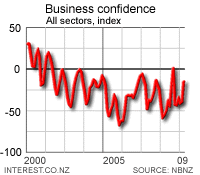 Unless the international banking crisis is going to hurt the NZ economy massively more than it has to date, it seems to me that aggressive OCR cuts right now will only exacerbate the roller coaster ride the economy has been subject to by past ill-conceived interest rate marching. Of course, the RBNZ's track record is one of excessive interest rate marching, while Governor Bollard has shown past inclination to be kind to Government during election years. There could be hint of politics in the current operation of monetary policy, as I have long argued would be the case in our regular reports on interest rate prospects (the Interesting Times and Monetary Policy Briefing reports), so maybe I should just go with the flow and not worry about businesses being whip-lashed by
Unless the international banking crisis is going to hurt the NZ economy massively more than it has to date, it seems to me that aggressive OCR cuts right now will only exacerbate the roller coaster ride the economy has been subject to by past ill-conceived interest rate marching. Of course, the RBNZ's track record is one of excessive interest rate marching, while Governor Bollard has shown past inclination to be kind to Government during election years. There could be hint of politics in the current operation of monetary policy, as I have long argued would be the case in our regular reports on interest rate prospects (the Interesting Times and Monetary Policy Briefing reports), so maybe I should just go with the flow and not worry about businesses being whip-lashed by 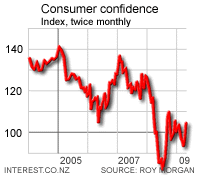 excessive interest rate changes. But for the long-term good of the country I can't help but hope that Governor Bollard has both learnt from his past mistakes and is taking note of the latest decisions made by the Fed and the European Central Bank (ECB). The current thinking of the mainstream central banks is to separate the operation of prudential management of the financial system from monetary policy or interest rate management. In coordination with Governments, the central banks are injecting capital/liquidity directly into stressed financial institutions that could threaten financial system security while they are injecting large doses of liquidity, like the coordinated injection by the Fed, Bank of Japan, ECB, Bank of England, Swiss National Bank and Bank of Canada last week into the financial system. However, as yet anyway, they are not making the mistake of dosing the whole economy with lower interest rates. So why should the RBNZ implement aggressive OCR cuts to deal with a US-international financial system problem that overseas central banks are not responding to by cutting interest rates? The media release by the RBNZ last week about the impact of the latest overseas developments on the local banking sector may be a sign that sanity will prevail - see here - but when it comes to central banks, sanity can be as scarce a commodity as 300 year old bankers. * Rodney Dickens is the Managing Director and Chief Research Officer for Strategic Risk Analysis (SRA), which is a boutique economic, industry and property research company. Rodney produces regular free reports on topical issues and on specific property markets. Find out more about SRA here and sign up to SRA's free reports here.
excessive interest rate changes. But for the long-term good of the country I can't help but hope that Governor Bollard has both learnt from his past mistakes and is taking note of the latest decisions made by the Fed and the European Central Bank (ECB). The current thinking of the mainstream central banks is to separate the operation of prudential management of the financial system from monetary policy or interest rate management. In coordination with Governments, the central banks are injecting capital/liquidity directly into stressed financial institutions that could threaten financial system security while they are injecting large doses of liquidity, like the coordinated injection by the Fed, Bank of Japan, ECB, Bank of England, Swiss National Bank and Bank of Canada last week into the financial system. However, as yet anyway, they are not making the mistake of dosing the whole economy with lower interest rates. So why should the RBNZ implement aggressive OCR cuts to deal with a US-international financial system problem that overseas central banks are not responding to by cutting interest rates? The media release by the RBNZ last week about the impact of the latest overseas developments on the local banking sector may be a sign that sanity will prevail - see here - but when it comes to central banks, sanity can be as scarce a commodity as 300 year old bankers. * Rodney Dickens is the Managing Director and Chief Research Officer for Strategic Risk Analysis (SRA), which is a boutique economic, industry and property research company. Rodney produces regular free reports on topical issues and on specific property markets. Find out more about SRA here and sign up to SRA's free reports here.

We welcome your comments below. If you are not already registered, please register to comment.
Remember we welcome robust, respectful and insightful debate. We don't welcome abusive or defamatory comments and will de-register those repeatedly making such comments. Our current comment policy is here.